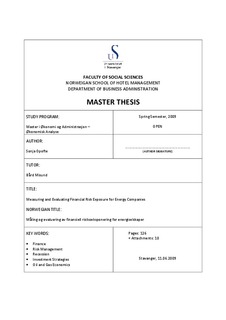| dc.description.abstract | Over the last decades, the energy industry has been exposed to significant changes within the
world marked. The intention of this thesis has therefore been to measure and evaluate financial
risk exposure for energy companies. Financial risk has been the primary subject of this thesis.
This subject has further been divided into one prediction and two hypotheses encompassing the
theoretical framework of this thesis; recession versus growth, financial risk and investments. The
prediction and hypotheses have been evaluated by applying both quantitative and qualitative
analysis. This thesis studies financial risk exposure and its influence on 16 major oil and gas
companies during a 20 year time period, from February 1989 to February 2009.
World market changes may provoke several changes in financial risk exposure facing energy
companies. These changes could provoke higher volatility, meaning significant changes in a
company’s stock price and could further revise future investment strategies. These considerations
form the basis for the first prediction in this thesis; “economic recession and resulting changes in
market risk factors increases the stock price volatility and changes the investment behavior for
energy companies.” The quantitative results points toward the highest volatility measurements in
periods of recession. This corresponds to the qualitative analysis, as the overall responses from
the depth interviews presumed the highest volatility measures in periods of recession. Based on
the quantitative and qualitative results the prediction stating that “economic recession and
resulting changes in the market risk factors increases the stock price volatility for energy
companies” is accepted. The investment behavior was further analyzed by evaluating the
reserves replacement rate and finding and development costs of each of the company represented.
Neither the quantitative nor the qualitative analysis points towards periods of recession causing
changes in the investment behavior for the companies analyzed, so the predicting stating changes
in a company’s investment behavior as the results of periods of recession is rejected.
Periods of recession and growth caused by world market changes could have dissimilar influence
on an energy company’s stock price, depending on size and value of company. The subsequent
hypothesis analyzed in this thesis therefore claimed that “the stock price is more influenced by market risk in periods of recession than in periods of growth”. The quantitative results show a higher relation between the market risk factors in periods of recession compared to periods of
growth. From the results of the t-test, oil and gas frequently proves a significant correlation at
given significance levels. This is similar to the qualitative analysis, as the financial personnel
ranked oil and gas price to provide the highest influence on a company’s stock price when asked
to compare this to other financial risk factors. Based on these results the hypothesis “the stock
price is more influenced by market risk factors in periods of recession than in periods of growth”
was accepted.
The financial risk exposure facing the energy companies can be viewed by evaluating the stock
price fluctuation, and further to apply models to calculate the historical expected stock return
based on included risk factors. These models are used to price risk and are therefore applied to
evaluate which of the presented models provides the most accurate measure of historical expected
stock return compared to the actual historic stock return. These models represent the final
hypothesis stated in this thesis, “increased number of financial risk factors included in a model
for pricing risk, gives a more accurate predicted historical stock return”. The results show that
Brent oil price, market cap and book-to-market ratio each have a significant impact on the
historic stock price return for the energy industry. Considering the calculation of expected
historical stock return based on the included systematic and unsystematic risk factors, the APT
multifactor model provides the most accurate model to explain historical expected stock return.
The APT model incorporated the following systematic risk factors: interest rate, market index,
exchange rate, oil price and gas price. These could therefore be considered as the most important
risk factors for predicting historical stock return. Based on the yearly analysis, increased number
of financial risk factors does not necessarily give more accurate predicted stock return. However,
if considering the monthly analysis, increased number of financial risk factors did actually give a
more accurate predicted stock return. | en |
